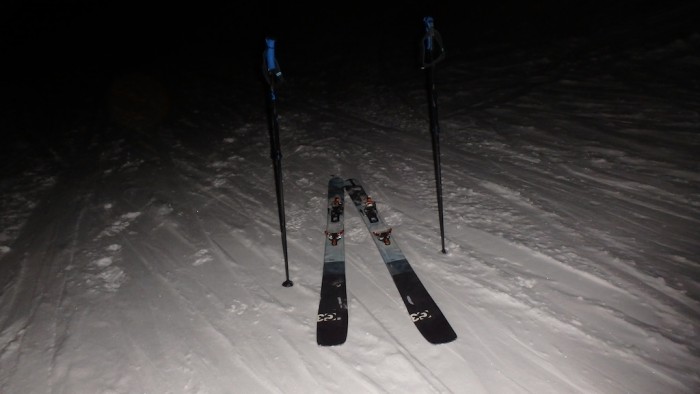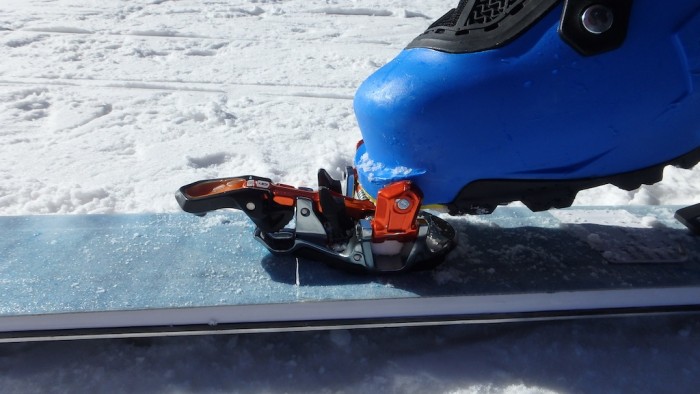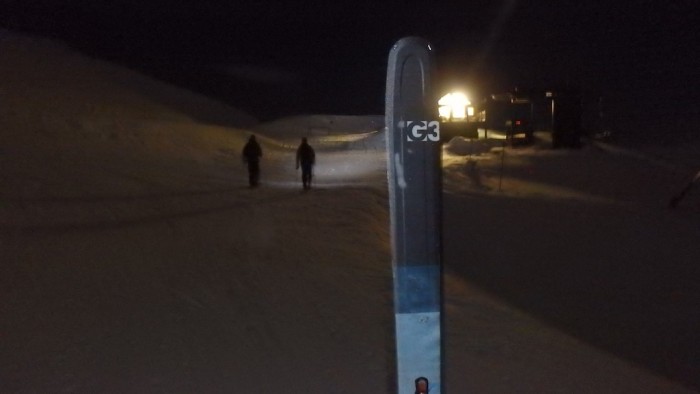
There’s something special about inbounds night laps that really gets the blood going. Maybe it’s the rush of almost outrunning your headlamp. Perhaps it’s the eerie shadows under trees where foxes scurry, their eyes glowing in the distance.
Or, it might be the fact that you really need to trust your skis to do their job. Out here at night, you’re on your own.
I felt fairly confident during recent nighttime ski workouts (and during several days) that the Boundary 100 from G3 would do the job. Over the last two months, it has proven a great performer out in the backcountry, and capable (but not ideal) ski when riding inbounds.
G3’s Ski Made to Cross Boundaries
The Boundary is aptly named. At 100mm under foot (129-100-117), it’s a middle-of-the-road profile that has proven a versatile ski shape, especially for those who ride a lot of packed powder out west. It’s a tad narrow for deep powder, but gets the job done.

It is billed as a “quiver of one,” meaning a ski that can do pretty much anything on the mountain. The shape and build certainly hit many of the design elements common in all-mountain skis.
It has what G3 calls “freeride rocker,” meaning a very well-accepted combination of camber under feet and early rise tip and tails. This results in a responsive ski that doesn’t catch edges, and is common across the industry in the all-mountain category.
It has a light poplar and paulownia wood core and two layers of Titanal aluminum that helps dampen vibrations. The ski has a low profile to help keep the weight down to a svelt 3 pounds 9 ounces for a single ski. It is reasonably light for touring (lighter than most skis of similar dimensions), but with enough mass and strength to cut through a little crud while ripping down the mountain.
G3 Boundary Ski Testing, Review
G3 sent over a pair of Boundaries in 185 to test this fall; mounted with the brand’s Ion 12 tech bindings. For the last couple of months, I’ve used them on several outings in Colorado including:
- Backcountry touring at Berthoud Pass
- Uphill skiing (and descents) at Arapahoe Basin and Loveland ski areas
- Inbounds skiing at Copper Mountain
- On a soft day on the moderately steep Vasquez Cirque at Winter Park
I’ve driven them with the Salomon MTN Lab ski boot.

Cutting to the chase, I’ve been pleased with this ski, with a few caveats.
Over soft snow, it floats well enough to keep my 150-pound body off the bottom, but it’s a little narrow for deep powder. On groomed terrain, it carves really well and holds an edge even when the snow gets icy. It is quick side to side in the bumps, allowing for confident skiing even when things get deeply rutted.
So yep, it’s a good all-around ski, and certainly light enough to skin comfortably up steep hills. No, it’s not a super light ski-mo racing rig, and on the downhills you’ll be glad you exchanged the extra weight for performance.
Yet, while I’m stoked on the ski’s ability to rip downhill under all the circumstances I’ve encountered, it still feels like a light ski.
This feeling is a hard thing to quantify, for the ski responds well to my input and overall does what I ask. But as with most touring skis I’ve tested, it’s a little more jittery than a heavier, dedicated alpine setup. The tips don’t exactly chatter, but you feel the snow more underfoot than with a heavier setup.
Hitting cut-up powder or chunks of frozen snow, the ski gets pushed around pretty easily due to its light weight. But that, in my opinion, is the tradeoff you make for a ski that can zip uphill with little effort.
Ion 12 Bindings
The Ion 12 has been a much-lauded touring binding, and I found no fault with the design. I am 5’8″ and weigh 150 pounds; I am an aggressive, expert skier, had the DIN set to 7, and never released from the binding in about 6 days of skiing.

The Ion 12 is extremely easy to use and adjust. Stepping in, it’s easy to find the pin holes on the boot. The heel risers flick up simply for climbing. The brake locks into the “up” position with the stomp of the foot. Switching between downhill and uphill modes is easy and intuitive; just spin the heel.
Many reviews have been written about these bindings, and most are positive (it’s won awards from Backcountry Skiing, Powder, and Freeskier). I’d concur that for a pintech binding, these are a solid value, although certainly not cheap at $550.
“One Ski Quiver” for Those Who Tour
So who should buy this ski? It really is a versatile ride, but for those who mostly ride lifts in resorts, the light weight is a negative.

This is a ski for the person who wants to tour on a solidly performing downhill ski that sometimes may ride it inbounds on days when side-country trips are likely. It wouldn’t be my only ski if I were alpine-oriented but it makes an excellent second ski for the person who wants to earn some turns.
The G3 Boundary 100 is available now, selling for retail of $650 (it’s available for significantly less online) and also comes in a women’s model, the Boundary 100W. For winter 2016-17, it will be re-branded as the ROAMr, with new colors to better match the new season lineup from G3.
It’s a great, moderately light ski for touring that handles the downhill challenges most skiers are likely to throw its way.






